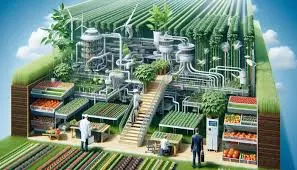Introduction: The Changing Face of Agriculture
Agriculture, the backbone of human civilization, has undergone monumental changes since the dawn of the agrarian age. From the use of hand tools to the mechanization of farms, every era has brought innovations that shaped food production. Today, agricultural technology (AgTech) stands at the forefront of this transformation, combining advanced tools, data analytics, and artificial intelligence to meet the demands of a growing global population while ensuring environmental sustainability.
What Is Agricultural Technology?
Agricultural technology encompasses a wide range of tools and systems designed to improve the efficiency, productivity, and sustainability of agricultural practices. These technologies can include:
Precision farming tools (e.g., GPS-guided tractors)
Drones and aerial imagery
IoT (Internet of Things) sensors for soil and crop monitoring
Smart irrigation systems
Biotechnology and genetic engineering
Data analytics and machine learning
Robotics and automation.
The Key Pillars of Modern AgTech
1. Precision Agriculture
Precision agriculture uses GPS technology, sensors, and data analytics to monitor and manage crops with pinpoint accuracy. Farmers can analyze data on soil conditions, weather, pest threats, and plant health to make informed decisions.
Benefits:
Optimized use of water, fertilizers, and pesticides
Increased crop yields
Reduced environmental impact.
2. Smart Irrigation Systems
Water scarcity is a growing concern in agriculture. Smart irrigation systems use soil moisture sensors and weather forecasts to determine the exact amount of water needed.
Examples:
Drip irrigation with automatic timers
IoT-based irrigation apps
Satellite-based water use monitoring
Impact: Saves water, reduces costs, and enhances plant health.
3. Drones and Aerial Imaging
Drones equipped with high-resolution cameras can survey vast fields quickly, capturing data that would take days to collect manually.
Applications:
Crop health monitoring
Pest and disease detection
Plant counting and mapping
Drones help identify issues early, enabling timely interventions and better crop management.
4. Robotics and Automation
Agricultural robots (AgRobots) are used for planting, harvesting, weeding, and sorting produce.
Innovations Include:
Autonomous tractors
Harvesting robots for fruits and vegetables
Robotic weed control systems
These machines increase labor efficiency and reduce reliance on human labor during peak seasons.
5. Biotechnology and Genetic Engineering
Advancements in biotechnology allow for the creation of genetically modified crops that are more resistant to pests, diseases, and climate change.
Popular Examples:
Drought-resistant maize
Pest-resistant cotton (Bt cotton)
Bio-fortified rice (Golden Rice)
Such innovations help improve food security and nutritional content.
6. Artificial Intelligence and Big Data
AI-powered tools analyze vast amounts of agricultural data to forecast trends, detect anomalies, and provide actionable insights.
Benefits:
Predictive maintenance of equipment
Yield prediction models
Market analysis for crop pricing
Machine learning algorithms can identify patterns invisible to the human eye, enhancing decision-making.
Sustainable Farming Through Technology
AgTech not only improves productivity but also plays a critical role in sustainable farming practices. By using resources efficiently, minimizing waste, and reducing chemical usage, technology helps mitigate the environmental impact of agriculture.
Examples of Sustainability in AgTech:
Vertical farming to reduce land use
Renewable energy (solar-powered equipment)
Organic farming supported by biological pest control.
Challenges in Adopting Agricultural Technology
Despite its benefits, several barriers hinder the widespread adoption of AgTech, especially in developing regions:
High initial investment costs
Limited internet connectivity in rural areas
Lack of technical knowledge among farmers
Resistance to change and traditional farming mindsets
Governments and private organizations must work together to provide education, subsidies, and infrastructure to overcome these challenges.
The Future of Agricultural Technology
The future of AgTech is promising, with continuous innovations expected in the fields of:
Synthetic biology: Designing crops with enhanced capabilities
Blockchain technology: Improving supply chain transparency
Climate-smart farming: Tools to combat climate change effects
Agricultural drones with AI: Real-time data and action capability
As climate concerns rise and food demands soar, agricultural technology will be the key to building a resilient, productive, and sustainable food system.
Conclusion: Embracing AgTech for a Better Tomorrow
Agricultural technology is more than just a trend; it is a necessity. With the global population projected to reach 9.7 billion by 2050, the pressure on our food systems will only intensify. By embracing AgTech, farmers, governments, and industries can work together to create a future where food is abundant, affordable, and sustainably produced.
As we move forward, the integration of technology into every aspect of agriculture will redefine how we grow, distribute, and consume food—ushering in a new era of innovation-driven farming.












.jpeg)


0 Comments